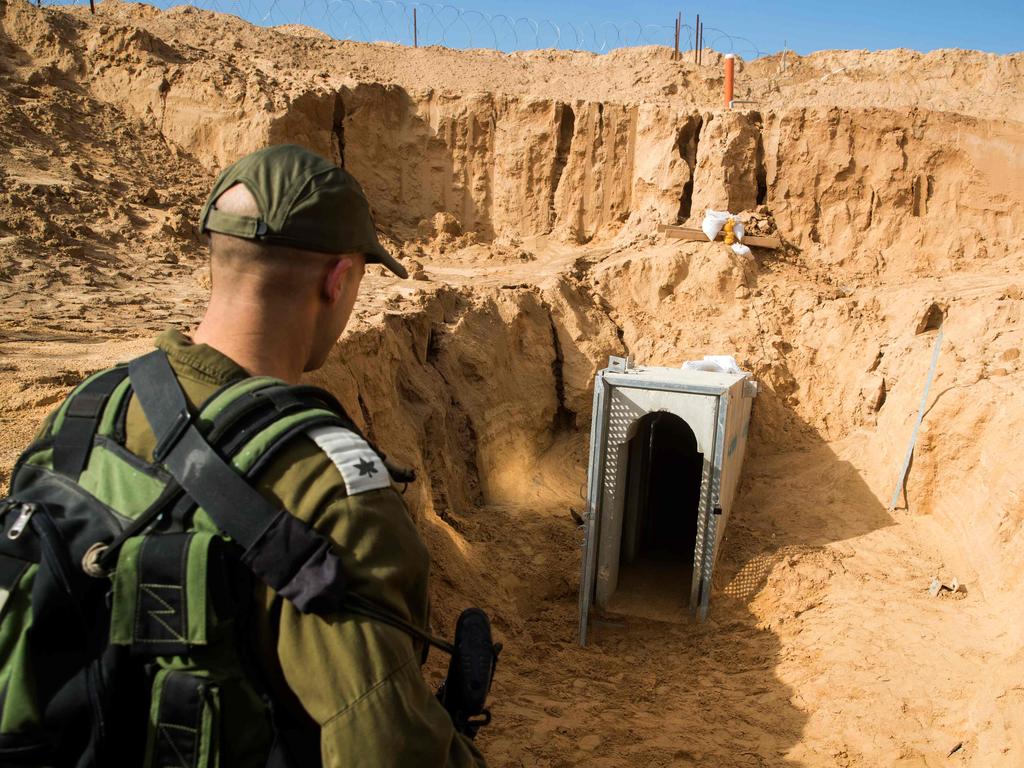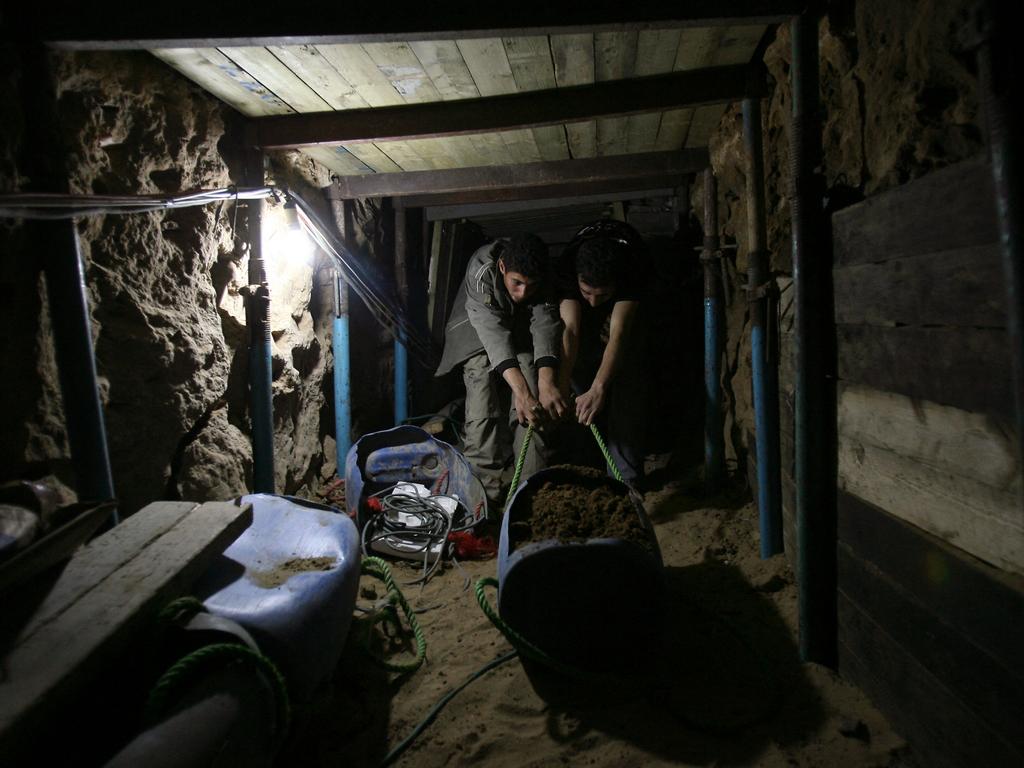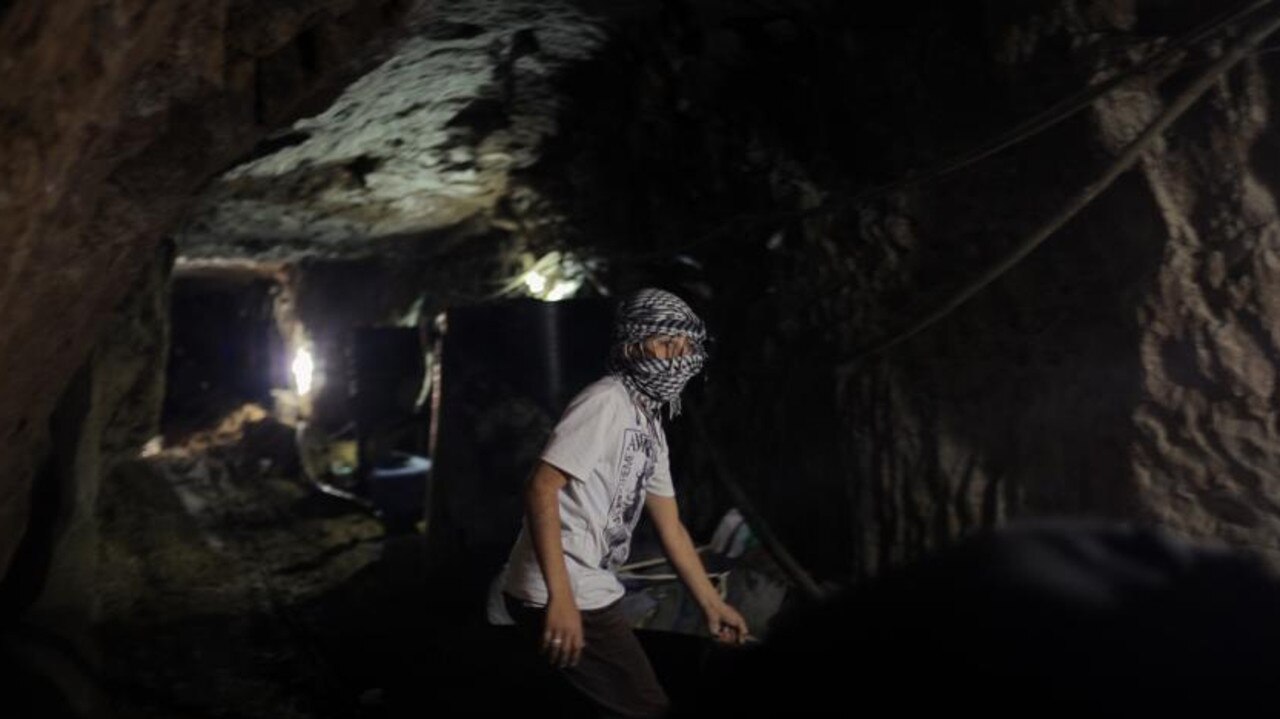Map of Gaza’s complex tunnel network reveals Israel’s mammoth task
Hamas can’t match Israeli firepower but it has one advantage over that may see it use this highly unconventional and unpredictable war tactic.
Hamas knows it can’t match Israeli firepower in the air, sea or ground. So it’s drawing the conflict into a territory over which its fighters have complete control: underground.
“You can’t see there. You can’t breathe there. You can’t communicate. You can’t navigate. You can’t shoot. You can’t do anything unless you have specialised equipment and specialised training,” says US West Point military academy urban warfare expert John Spencer. “At this scale, it will be a massive challenge.”

It’s a challenge of which Israel’s defence force is well aware.
“Think of the Gaza Strip as one layer for civilians and then another layer for Hamas. We are trying to get to that second layer that Hamas has built,” a military spokesperson said.
And it has had a taste of this network before.
During a 2021 clash within the Gaza Strip, Israel claimed it used precision air strikes to demolish more than 100 kilometres of tunnels. Hamas retorted that it had 500 kilometres of tunnels, and only 5 per cent had been damaged.
Gaza has been under land, sea and air blockade by Israel since 2007.
The only way to bypass the concrete barriers, barbed-wire fences, patrol routes and sensor nets is to go beneath it all.
And that labyrinth of tunnels – complete with plumbing and electricity – is likely to have been dug mostly by hand.
But they’re no longer just smuggling lanes or bolt-holes for militants.
They hide rockets and their factories. They disperse arms and ammunition. They carry communications cables safely out of reach of Israeli wire-tappers. They contain communications centres, assembly halls, barracks – even prisons. And what goes on down there is safely out of sight of surveillance aircraft and satellites.

This week, Israel Army Lieutenant-General Herzi Halevi promised to “enter Gaza, to go to the places where Hamas is preparing, acting, planning, launching” and to “attack them everywhere, every commander, every operative, destroy infrastructure.”
It’s almost sure to be a long, bloody fight.
Underground highways
Palestinian militant groups have been resorting to tunnels to avoid Israeli surveillance and blockades for decades. Hundreds were built beneath the Egyptian border after it was closed in 1981 to smuggle everything from ammunition and weapons to embargoed goods.
Eventually, Egypt attempted to destroy the network by collapsing or flooding as many as possible.
But tunnelling was quickly adapted for a more aggressive purpose. One was uncovered in 2013 near an Israeli town after residents heard digging. The size and quality of that tunnel – including prefabricated concrete walls – prompted the Operation Protective Edge ground offensive in 2014. This went on to locate and destroy more than 30 invisible breaches in the Gaza border.
“Hamas had a plan. A simultaneous, co-ordinated, surprise attack within Israel,” an Israeli military spokesman said at the time.

Since then, Israel has spent billions adding extensive underground concrete barriers lined with advanced sensors to its existing Gaza border wall. This network was completed in 2021.
But ground penetrating radar and vibration sensors have limits. They’re generally believed not to be able to reach much more than 20 metres deep.
And Hamas has learnt new lessons from the Syrian and Islamic State conflicts and used these to turn their subterranean retreats into labyrinthine fortresses.
“Hamas will have been preparing for an IDF ground assault and knows these tunnels inside and out — some of them are likely booby-trapped,” the Soufan Group international think-tank has assessed. “Preparing to fight in such terrain is incredibly difficult and would require extensive intelligence on what the network of tunnels looks like, which the Israelis may not have.”
The Gaza ‘metro’
Clive Williams was an Australian Army platoon commander when his unit discovered the Vietnamese Cu Chi tunnel complex in 1966. He’s told the Australian Strategic Policy Institute (ASPI) that such an underground fortress would give Hamas a distinct advantage.
“Insurgent forces that lack the capability to take on regular forces head to head can use tunnels to fight a survivable war of attrition that may eventually lead to war weariness and a negotiated settlement,” he says.
And Hamas has spent decades digging its network for precisely this purpose.
“There is virtually another city below the streets of Gaza,” says West Point Modern War Institute director John Amble. “That’s going to play a huge role in enabling defenders to move between strong points and to put up a stiff and probably pretty effective defence.”
He explains that Israeli troops will struggle to move through bombed buildings and rubble-strewn streets. Meanwhile, Hamas “hunter-killer groups” will be able to appear and disappear virtually at will.

Many of the tunnels are believed to be about 30 metres beneath the surface and accessed through the basements of high-traffic, high-rise apartments, offices and public buildings. One tunnel discovered in 2020 went as deep as 70 metres.
But the sheer scale of the network presents yet another threat to the Palestinian population.
In 2021, Israeli air strikes blasted a network of tunnels in Gaza City. This triggered the foundations of several high-rise buildings to collapse, killing dozens of civilians.

Similar scenes are evident in footage emerging from the current war.
“It is not an easy endeavour because Hamas has embedded itself inside and underneath the Gaza Strip,” Israel army spokesman Lieutenant Colonel Jonathan Conricus told media this week. “That is how Hamas has been able to hide countless rockets in all of these clashes that we’ve had. That is where they’re hiding now as we’re bombing. That is where their weapons are. That’s the military infrastructure that they rely on in order to keep on fighting.”
Gateways to Hell
Urban warfare is bad enough. Closely packed houses, offices and shops are full of shadows and limited lines of sight. Fighting is therefore at close quarters. And radio communication is usually tricky.
Underground warfare makes each of these things far worse. Which is why tackling every tunnel requires extensive preparation before specialist troops are committed to combat.
“Hamas has spent two decades building the labyrinth of deep, defensive tunnels to resist any ground assault by Israeli troops,” Williams says.

The first phase in neutralising this network will be for ground troops to secure northern Gaza. Only then could specialist units begin the search-and-destroy process.
“This phase could be costly in terms of Israeli lives because Hamas fighters underground will have access to the surface to inflict casualties on Israeli troops — in much the same way as Islamic State fighters did in Mosul when they inflicted heavy casualties on advancing Iraqi soldiers,” he adds.
But West Point’s John Spencer says Israel has been preparing for this kind of war.
Its air force is already dropping ground-penetrating GBU-28 bombs. These can punch through 30 metres of dirt or 5 metres of concrete before exploding. And they’re being used to collapse entry points to Hamas underground refuges and the shallow fighting tunnels that enable rapid movement beneath Gaza City.
Strategically placed explosive charges are an alternative, Spencer says. But that requires the tunnel already be neutralised and about 10 tonnes of explosives hauled into place to guarantee its destruction.
Another option is to use semi-autonomous vehicles. These could map obstacles, detect traps and even engage Hamas fighters. But these often get stuck, break down, and lose contact with their operators.
Ultimately, though, troops must still enter a tunnel or bunker to ensure it has been cleared.
Wicked game
Once Israeli special forces get into the tunnel system, things will likely get much worse.
“It will be a costly process because Hamas is intimately familiar with the environment and has had time to booby-trap the tunnels and prepare defensive positions underground,” Williams explains.
Spencer notes a single Hamas defender can hold a narrow tunnel against a much superior Israeli force.

“Entering tunnels presents unique tactical challenges, many of which cannot be addressed without specialised equipment,” he says. It may be impossible to breathe without oxygen tanks. Navigation relative to the surface is all but impossible. And traditional light-amplification goggles are useless in complete darkness.
“A weapon fired in compact spaces of tunnels, even a rifle, can produce a concussive effect that can physically harm the firer,” he adds.
But Israel has equipped itself to mitigate this. It has specialist communications and navigation equipment. It uses infra-red and other technologies to see in the pitch black. And it has an arsenal of robots that can roam ahead of advancing troops.
It has also formed several specialist subterranean combat teams, such as a group of engineers known as the “Samur” (Weasels).
But they have an enormous task ahead of them.
“The scale of the challenge in Gaza, where hundreds of miles of tunnels crisscross below ground in the enclave, is entirely unique,” Spencer explains. “This expansive underground complex is the wicked problem — one for which no perfect solution exists — awaiting Israeli ground forces.”
Jamie Seidel is a freelance writer | @JamieSeidel






